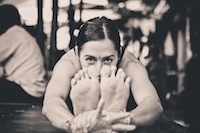Lured by pictures of lithe beauties doing backbends in hammocks, Healthista’s yoga blogger Genny Wilkinson-Priest tried Yogaria or aerial yoga, the latest new yoga hybrid
It was the photo that got me. A lithesome beauty, floating upside down beneath a tree in a graceful backbend supported by a silky sling. It’s not that it looked easy – far from it. But it looked serene and meditative.
And a little bit wacky.
Yogaria (pronounced Yo-GAH-ria and meaning Yoga Air) quite literally takes yoga off the mat, allowing you to explore gravity as well as earth while still performing a variety of classical yoga postures.
It was a rainy Friday night, and truthfully I wasn’t in the mood to try something new after a long week of work, work, work, and kids, kids, kids. I pushed my way through the massing throngs of young people in search of a party in Soho, to Triyoga in Kingly Court where yoga teachers Liz Lark and Bea Perini had hung 12 silky, stretchy “cocoons” from the rafters.
Candles flickered. People spoke in hushed tones. Some students were already playing with the blue cocoons, wrapped up in its warmth and swaying gently mid-air. Things were looking up – this looked a better way than rounds of vodka tonics to erase the memory of a stressful week.
Still, I was a bit uneasy. What if the harness securing the cocoon to the rafter snapped while I was upside down in an inversion? I looked up at the metal clips and gave several firm yanks on the cocoon. It looked solid, and I was subsequently assured by Triyoga management that a professional rigger sets up and tests the cocoons.
Jean is a senior instructor at Triyoga, London, and her Vinyasa Flow classes are regularly packed out. Her body is one of those seemingly built for the creative movements of dance and the detailed alignment of yoga (slender, strong, bendy and graceful), and you can easily see how Yogaria was borne out of her experience in both disciplines. Bea, meanwhile, is an “aerial dancer” and together with Jean and another co-creator (Daniela Essart) they have run Yogaria classes at Triyoga for two years.
They had the class warm up with two people sitting opposite one another with the cocoon in between them. Nothing too unusual or difficult here – seated twists, forward bends and backbends while my partner and I held on to the stretchy cocoon.
The class was then split into two groups, and my group moved to the far end of the large studio to practice restorative postures on the mats with Bea, while the other group of 12 started off in the cocoons with Jean.
Using a variety of props – bolsters, straps and bricks – we held soothing, well-supported poses for minutes at a time. The poses were not hard, and before long I had shed any restlessness and busy-ness and settled into a place of quiet.
After about 30 minutes of this bliss, we moved to the cocoons. I watched Jean slink into hers, and gamely tried the same but with not quite the same effect. I could get one leg in, but I had no sense of stability when I tried to pull in the other leg. While Jean was sitting in her cocoon wrapped up like a little Cosmic Egg, I was desperately trying not to fall backward, or even forward. In fact, I was just trying not to fall. It’s surprising how afraid you become of falling when you’re just 18-inches off the ground.
Clearly my 13 years of yoga practice was working against me. Where was the mat? The cocoon swung around, sometimes wildly, with me gripping on to it (which proved to be good shoulder work.) That’s the point of course. In order to immerse yourself fully in cocoon world, you need to surrender to the feeling of lost gravity. Of air.
I couldn’t stop laughing, at myself. I was the Mr. Bean of Yogaria.
I’m not sure if others had this problem. They looked a bit more graceful than me, though I couldn’t get a good look because my damned cocoon kept swinging about. At times I felt nauseous. Other times, claustrophobic. I put this down to the fact that I was totally neophyte at this anti-gravity yoga. Jean and Bea looked utterly blessed out in their slings.
Eventually I was able to get enough control – by sticking my hand out of the cocoon and grabbing the floor – to execute a few backbends and inversions.
I wish I had spent more time in the cocoon to get used to it. Out of the two-hour class, I was probably only in it for 40 minutes. But it’s tough work, and Triyoga said it’s too much for some people who might not have enough strength in their shoulders and arms to stay in the cocoons for the whole class.
I can see another reason why it’s important to practice on the mat during these classes – the “grounding” nature of the restorative mat work is supposed to enhance the opposing experience of floating in the air.
But in my case, the opposing experiences only served to reinforce the fact that yoga for me is best done with my two feet firmly planted on the ground.
Find out more on Jean Hall’s website

Read more from Genny :
Think you can’t do a headstand?
I did intense yoga until the day I gave birth
Some days I feel like I could fly
Like this article? Sign up to our newsletter to get more articles like this delivered straight to your inbox.






















































